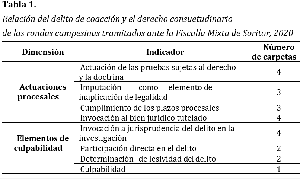List of the crime of coercion and customary law of the peasant rounds processed before the Soritor Mixed Prosecutor's Office, 2020
DOI:
https://doi.org/10.51252/rcri.v3i2.503Keywords:
guilt, positive law, communal jurisdiction, harmfulness, procedural deadlinesAbstract
The general purpose of this article was to determine the relationship between the crime of coercion and the customary law of the peasant rounds processed before the Soritor Mixed Prosecutor's Office, said in this way that contrasted with the provisions of the Political Constitution of Peru in its art. 149 about the guarantee that the peasant rounds have in exercising justice regarding jurisdictional functions within their territorial scope in accordance with customary law, as long as they do not violate the fundamental rights of the person. The type of research was a quantitative approach, with characteristics of the basic descriptive level method, the design was non-experimental where the problem was observed within the natural context of analysis, with a total of 23 folders analyzed as a population. The results show that the peasant rounds act based on the imputation of the evidence of direct participation in the crime of coercion, but that customary law does not determine or limit their action in search of justice, therefore it is concluded that aspects of customary law dinary obey the aspects of the characteristics of the investigative process equivalent to the limits of communal jurisdiction and ronderil having.
Downloads
References
Acosta Quiróz, C. O. (2018). Incompetencia de la Jurisdicción Penal ordinaria en las denuncias de coacción contra los miembros de las rondas campesinas de chota [Universidad Nacional de Trujillo]. http://dspace.unitru.edu.pe/handle/UNITRU/11621
Alvárez, A. (2008). Estado , democracia y seguridad ciudadana (1st ed.). PNUD.
Ardito Vega, W. (2002). Justicia de paz en el Perú. Allpanchis, 59(60–11), 13–38. https://revistas.ucsp.edu.pe/index.php/Allpanchis/article/view/560/525
Baquiax Bulux, J. B. (2017). El control de convencionalidad en el ámbito de los derechos de los pueblos indí-genas en Guatemala: Crítica sobre sus perspectivas actuales [Universidad San Carlos de Guatemala]. http://www.postgrados.cunoc.edu.gt/tesis/7646cc04a3b221a80c648a6ddf2b52e6 44705d6f.pdf
Bramont-Arias, L. A. (1995). Código penal anotado (3rd ed.). Editorial San Marcos.
Castillo Alva, J. L. (2016). Principios de derecho penal : Parte general (1st ed.). Gaceta Jurídica.
Congreso de la República. (2017). Derecho consuetudinario, sistemas penales y acceso a la justicia (pp. 80–89). https://www2.congreso.gob.pe/sicr/cendocbib/con2_uibd.nsf/AE51204970395F5705257687005096A0/$FILE/Capitulo_VI.pdf
Guzmán Solano, N. (2016). Struggle from the margins: Juridical processes and entanglements with the Peruvian state in the era of mega-mining. The Extractive Industries and Society, 3(2), 416–425. https://doi.org/10.1016/j.exis.2016.02.004
IIDS. (2022). VI Congreso Regional de Rondas Campesinas de la Región San Martín. Instituto Internacional de Derecho y Sociedad. https://www.derechoysociedad.org/congreso-regional-de-las-rondas-campesinas-de-san-martin-reafirma-su-decision-jurisdiccional-sobre-el-caso-de-la-familia-diaz-siguenas/
OIT. (2014). Convenio Núm. 169 de la OIT sobre Pueblos Indígenas y Tribales. Declaración de las Naciones Unidas sobre los Derechos de los Pueblos Indígenas. In Oficina Internacional del Trabajo (Vol. 53, Issue 9). http://www.ilo.org/wcmsp5/groups/public/---americas/---ro-lima/documents/publication/wcms_345065.pdf
Olórtegui, M. J., & Maradiegue Ríos, R. (2017). Rondas campesinas y nativas en el ejercicio de la seguridad ciudadana de la región de San Martín. Revista Ciencia y Tecnologia, 13(2). https://go.gale.com/ps/i.do?id=GALE%7CA597517556&sid=googleScholar&v=2.1&it=r&linkaccess=abs&issn=18106781&p=IFME&sw=w&userGroupName=anon~240d50ae
Peña Cabrera Freyre, A. (2015). Tratado de Derecho Penal. Estudio Programático de la Parte General (3rd ed.). IDEMSA.
Robles Pérez, C. L. (2016). Análisis de la aplicación del derecho consuetudinario en los delitos de coacción en los procesos penales en el departamento de Chimaltenango [Universidad Rafael Landívar]. http://recursosbiblio.url.edu.gt/tesisjcem/2016/07/07/Robles-Carlos.pdf
Soto Aguilar, M. E. (2014). Límites del acceso a la justicia de los pueblos indígenas: Análisis jurídico del pe-ritaje cultural como medio de prueba dentro del proceso penal costarricense, para el respeto de la identidad cultural de los miembros de pueblos indígenas [Universidad de Costa Rica]. https://iij.ucr.ac.cr/wp-content/uploads/bsk-pdf-
Tam, J., Vera, G., & Oliveros, R. (2008). Tipos, Métodos y Estrategias de investigación Científica. Pensamiento y Acción, 5, 145–154. http://www.imarpe.pe/imarpe/archivos/articulos/imarpe/oceonografia/adj_modela_pa-5-145-tam-2008-investig.pdf
Tribunal Constitucional del Perú. (2009). Recurso de agravio constitucional interpuesto por don Jaime Hans Bustamante Johnson contra la Resolución de la Primera Sala Mixta Descentralizada de la Corte Superior de Justicia de San Martín. EXP. N°03343-2007-PA/TC. https://tc.gob.pe/jurisprudencia/2009/03343-2007-AA.pdf
Vicente Cabedo, M. (2005). Constitucionalismo Y Derecho Indígena En América Latina (1st ed.). Universitat Politècnica de València.

Published
How to Cite
Issue
Section
License
Copyright (c) 2023 Karolayn Olenka Hidalgo-Wilson

This work is licensed under a Creative Commons Attribution 4.0 International License.
The authors retain their rights:
a. The authors retain their trademark and patent rights, as well as any process or procedure described in the article.
b. The authors retain the right to share, copy, distribute, execute and publicly communicate the article published in the Ratio Iure Scientific Journal (RCRI) (for example, place it in an institutional repository or publish it in a book), with an acknowledgment of its initial publication in the RCRI.
c. Authors retain the right to make a subsequent publication of their work, to use the article or any part of it (for example: a compilation of their works, notes for conferences, thesis, or for a book), provided that they indicate the source of publication (authors of the work, journal, volume, number and date).






